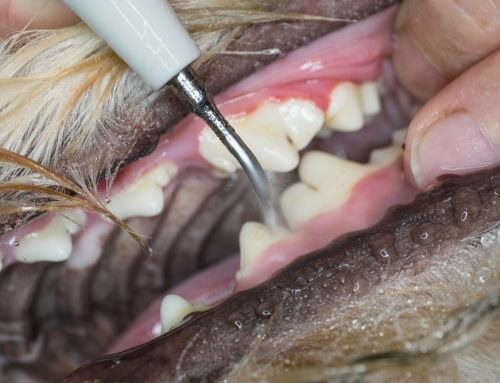Each year, millions of cats and dogs receive a cancer diagnosis. While dogs develop cancer at about roughly the same rate as people, less is known about the cancer rate in cats, but each and every diagnosis is devastating to the pet owner. To help pets live longer after a cancer diagnosis, with a better quality of life, early detection is crucial. Keep a close eye on your pet for warning signs, so you can immediately schedule an exam with one of our Southern Crossing Animal Hospital veterinarians to get to the bottom of your furry pal’s problem. Remember this rule of thumb—when in doubt, check it out—when dealing with a potential neoplastic process. It is always better to be safe than sorry, and if the diagnostic testing we perform reveals your pet does have cancer, early detection can make all the difference in your pet’s prognosis, and grant us a better chance of successful treatment.
Cancer is the leading cause of disease-related deaths in older cats and dogs. Carefully monitor your beloved companion for the following 10 most common cancer signs in pets, to catch it quickly.
#1: Chronic weight loss or weight gain
If you haven’t made any changes in your pet’s exercise schedule or food intake, but they continue to lose or gain weight, they have an underlying illness. A large mass in the abdomen can make your pet look bloated, despite sucking nutrition from the rest of the body, and leaving your pet bony and thin in other areas. Cancers that do not create large growths, but still continue to sap your pet’s nutrition, can lead to drastic weight loss. Any changes in your pet’s weight, both sudden and gradual, should be evaluated.
#2: Bleeding or discharge from any opening
Bleeding from the nose or mouth is a common sign of a malignant tumor located in these areas. Occasionally, a pet will have blood in the stool or urine, if they have a malignant tumor in the intestinal tract or bladder, so any blood or abnormal discharge warrants a veterinary exam.
#3: Change in appetite
Pets with cancer tend to have decreased appetites, to match their declining health. Tumors can press on their stomach, intestinal tract, or esophagus, making eating, drinking, or swallowing difficult, while oral melanomas, and other masses, can make chewing painful. A cancerous process may also stimulate your pet to eat items or foods they normally wouldn’t, so be wary of any appetite change.
#4: Difficulty breathing
Difficulty breathing, coughing, or shortness of breath can indicate conditions other than cancer, such as respiratory illnesses or heart disease, but can also be cancer signs. Many cancers metastasize primarily to the lungs, which can inhibit normal lung expansion, and interfere with oxygen transfer. Any breathing issues should always be immediately evaluated, to ensure your pet is oxygenating adequately.
#5: Persistent limping or lameness
Pets routinely injure themselves and can suffer from torn cranial cruciate ligaments, muscle sprains and strains, or cracked bones, that can all cause limping or lameness. But, if your pet fails to improve with rest and exercise restriction, an appointment is necessary to determine the underlying cause. Bone cancers, such as osteosarcoma, and nerve sheath tumors are extremely painful, and your pet may develop a persistent limp that fails to improve with rest, and sometimes medication. Osteosarcoma tends to form a painful, swollen mass on a leg’s long bones that is firm to the touch, so any noticeable swelling should be examined.
#6: Difficulty urinating or defecating
While straining to urinate or defecate can indicate a whole host of issues, they can also be cancer signs. Tumor formation in the bladder, intestinal tract, or around the rectum is common in older pets, and can make urinating or defecating difficult.
#7: Vomiting or diarrhea
Throughout your pet’s life, you will likely see several bouts of vomiting and diarrhea that usually resolve simply, with a bland diet and probiotics. But, frequent or persistent vomiting and diarrhea is cause for concern. Although these two signs are vague, and can indicate many varied diseases, they can also mean your pet has cancer.
#8: Enlarged or changing lumps or bumps
Most commonly, people think of lumps or bumps that suddenly pop up as cancer, and abnormal growths can certainly be cancerous. However, pets routinely develop non-malignant lumps, such as allergic reactions, lipomas, cysts, or adenomas. Many pets tend to follow their first lump with more lumps, so keep a close eye on your pet, and ensure our team checks each future lump.
#9: Sores that do not heal
If a body sore fails to heal, that can be a clear indicator that a cancerous process, or a serious infection, is suppressing the immune system from working properly.

#10: A foul mouth odor
Oral tumors, which are relatively common in cats and dogs, are locally invasive, aggressive masses that can quickly cause a foul odor from your pet’s mouth. If you notice bleeding from the mouth, difficulty chewing, or a bad smell, a tumor may be forming.
Have you noticed one of the 10 cancer warning signs in your pet? Call us, to schedule an appointment for a comprehensive exam.







The thing that struck me the most is when you said that you should be concerned when your cat persistently vomits and suffers from diarrhea as they may be a sign of diseases. With this in mind, I will convince my sister to bring her two-year-old car to an animal hospital for a checkup. She said that her pet has lost a lot of weight due to diarrhea problems that have been on and off for the past weeks. She surely wants her cat to be treated well.